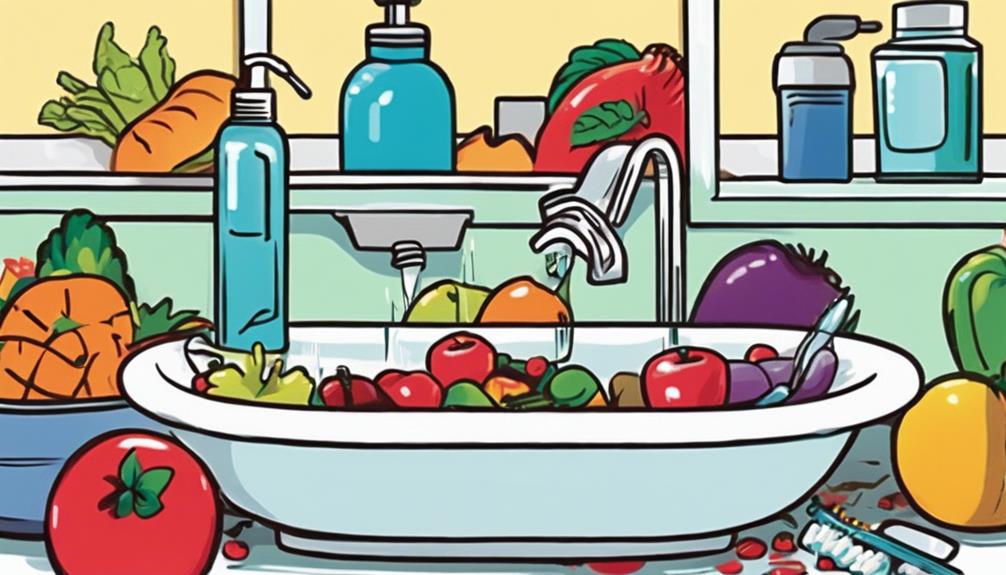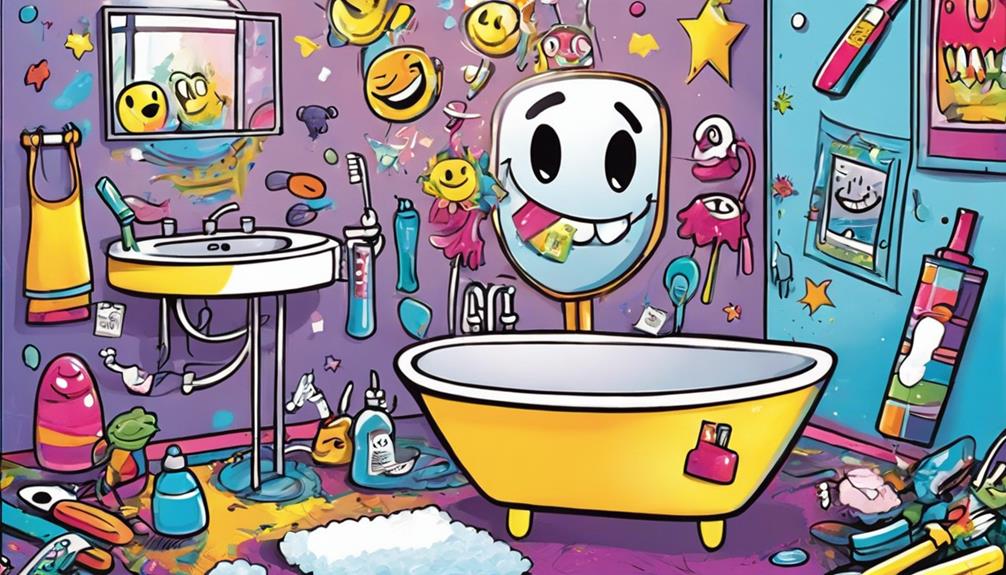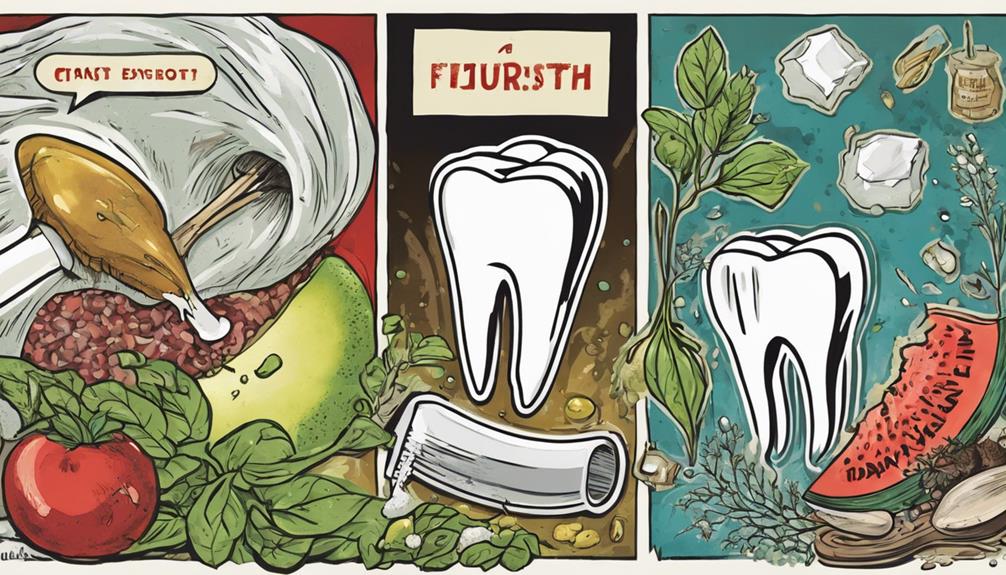Kids should avoid sugary snacks because they can lead to serious health issues. Excess sugar increases the risk of obesity, Type 2 diabetes, and dental problems. Plus, sugary treats often displace healthier foods, resulting in nutrient deficiencies. You might notice mood swings or sluggishness, which can ruin learning experiences. The American Heart Association recommends limiting added sugars to less than 25 grams daily for kids. By choosing nutritious options instead, you support better eating habits. Curious about how to make healthier snack choices together?
Key Takeaways
- Excessive sugar intake can lead to obesity, high blood pressure, and Type 2 diabetes in children.
- Sugary snacks displace healthier foods, resulting in nutritional deficiencies that affect growth and development.
- High sugar consumption contributes to dental problems, including cavities, impacting overall health.
- Hidden sugars in processed foods complicate dietary management, making it essential to read labels carefully.
Sugar Intake Recommendations

The American Heart Association recommends that kids aged 2 to 18 should stick to less than 25 grams (about 6 teaspoons) of added sugar each day to help reduce health risks. Monitoring your child's sugar intake is crucial, as excessive added sugars can lead to serious health issues like obesity, high blood pressure, and Type 2 diabetes. By keeping added sugars in check, you're setting up your child for a healthier future.
When kids consume sugary treats, they often displace healthier foods like fruits and vegetables in their diet. This can result in nutritional deficiencies that impact their growth and development. To guarantee your child gets the nutrients they need, focus on providing healthy foods that are low in added sugars.
Encouraging a balanced diet rich in whole foods helps kids develop better eating habits from an early age. You can introduce naturally sweet alternatives, such as fresh fruit, to satisfy their sweet tooth without the negative effects of added sugars. By being mindful of sugar intake, you're not just protecting their health today but also reducing their risk for heart disease in the long run.
Understanding Sugar Content

Understanding sugar content helps you make informed choices about your child's diet and manage their overall sugar intake effectively.
One key fact to remember is that 4 grams of sugar equals 1 teaspoon. This simple conversion can guide you in evaluating how much sugar is in various foods. You might be surprised to learn that about 70% of processed foods contain added sugars, which can complicate your dietary decisions.
Since the FDA updated the Nutrition Facts label in 2016, it's become easier to spot these added sugars. Look for terms like high-fructose corn syrup and cane sugar on ingredient lists, as recognizing these names is essential for managing sugar intake.
Common sources of sugar include breakfast cereals, which can pack around 12 grams of sugar per cup, and fruit snack bars, which also average about 12 grams. By being aware of the sugar content in these foods, you can make better choices for your child and help reduce their overall sugar consumption.
Health Risks of Excess Sugar
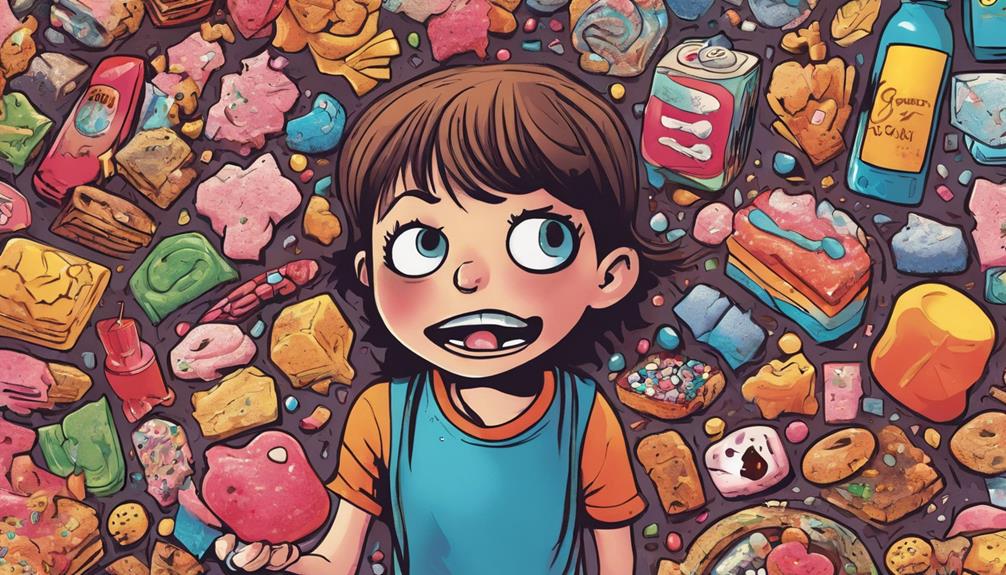
How can excess sugar impact your child's health in both the short and long term? The health risks of excess sugar are significant and can affect their overall well-being.
When kids consume high amounts of added sugar, they often replace nutrient-dense foods with high-calorie, low-nutrient options. This shift can lead to obesity, which is a major risk factor for developing Type 2 diabetes later in life.
In addition to weight gain, a diet high in sugary snacks can contribute to dental problems, as bacteria feed on sugar and produce acids that damage tooth enamel, leading to cavities. Furthermore, excessive sugar intake can also influence your child's behavior, causing mood swings and sluggishness that may hinder their learning and emotional health.
The American Heart Association recommends limiting added sugars to less than 25 grams per day for children aged 2-18. This guideline helps mitigate the health risks of excess sugar and supports your child's growth and development.
Encouraging Healthier Choices

To encourage healthier choices, start by offering your kids tasty alternatives to sugary snacks.
You can promote mindful eating by helping them recognize their hunger cues and involving the whole family in meal times.
When you model positive eating habits, your kids are more likely to make better food decisions themselves.
Offer Healthy Alternatives
Offering healthy alternatives like fruits and vegetables not only satisfies kids' cravings but also helps them develop better eating habits. With 80% of kids' foods containing added sugar, providing nutritious choices becomes essential in steering them away from processed foods.
Here are some healthy snack alternatives to evaluate:
| Snack Type | Healthy Alternative | Benefits |
|---|---|---|
| Sweet Snack | Fresh fruit slices | Natural sweetness, fiber |
| Crunchy Snack | Veggie sticks with hummus | Vitamins, healthy fats |
| Baked Good | Low-sugar granola bars | Controlled sugar intake |
| Grab-and-Go Option | Homemade blueberry muffins | Nutrients without added sugar |
| Reward | Stickers or small toys | Non-food incentives |
Promote Mindful Eating
Encouraging kids to practice mindful eating helps them better understand their hunger and fullness cues, paving the way for healthier choices. When you teach your child to pay attention to their body's signals, they're less likely to overindulge in sugary foods. Mindful eating fosters self-regulation without needing strict rules or restrictions.
Incorporating a variety of healthy meal options into your child's diet empowers them to make informed choices that align with their nutritional needs. This approach nurtures a positive relationship with food, steering them away from an over-reliance on sugary snacks. Gradually introducing healthy foods, like vegetables, can enhance acceptance and preference, making it easier for your child to choose nutritious options.
Modeling healthy eating habits yourself is essential. When your child sees you enjoying fruits and vegetables, they're more likely to follow your lead. By creating an environment that values mindful eating, you help your child develop lifelong habits that prioritize health over convenience.
Ultimately, promoting mindful eating not only encourages healthier choices but also equips your child with the skills necessary to navigate their food options wisely.
Involve Family Meals
Involving your family in regular meals fosters a supportive environment where healthy eating habits can thrive. When you gather around the table, not only do you enjoy each other's company, but you also set the stage for making better food choices.
Here are a few benefits of family meals that can help reduce sugar intake:
- Model Healthy Eating: Kids learn by watching you; your choices influence theirs.
- Encourage Participation: Involve children in meal prep to spark their interest in nutritious foods.
- Discuss Nutrition: Talk about food choices to empower them with knowledge about balanced diets.
- Routine Matters: Establishing regular family meals promotes mindful eating and awareness of hunger cues.
Managing Sugar Consumption

Managing sugar consumption is essential for your child's health, and there are practical steps you can take to make it easier. Start by limiting added sugars to less than 25 grams (6 teaspoons) per day, as recommended by the American Heart Association for kids aged 2-18.
One effective strategy is to prepare homemade snacks, which allows you to avoid the high-sugar items often found in processed foods.
Reading food labels is vital in this process. You'll find that about 70% of processed foods contain hidden sugars, often listed under various names. By checking these labels, you can make informed choices and steer clear of unnecessary added sugars.
Another helpful approach is to gradually reduce sugar in your child's diet instead of cutting it out entirely. This way, your child can adjust to healthier options without feeling deprived.
Additionally, consider using non-food rewards, such as stickers or small toys, to reinforce healthy eating habits. These strategies will help you manage sugar consumption effectively and promote a healthier lifestyle for your child.
Hidden Sources of Sugar
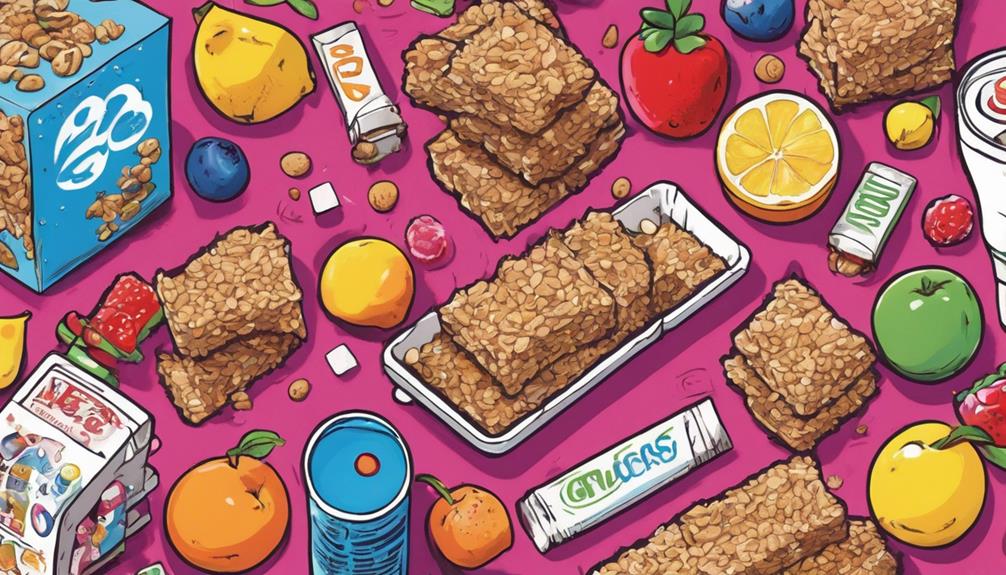
Despite your best efforts to limit sugar, hidden sources can easily sneak into your child's diet. It's vital to stay vigilant, as many packaged foods contain added sugar that you mightn't even expect.
Here are some common culprits:
- Smoothies: Often loaded with hidden sugars, sometimes exceeding daily limits.
- Gummy snacks: Just a single serving can pack 3-4 teaspoons of added sugar.
- Bottled fruit juices: These may seem healthy but can increase the risk of overweight in toddlers by 30%.
- Yogurt: Flavored varieties can contain significant hidden sugars.
With approximately 70% of processed foods containing hidden sources of sugar, reading labels becomes essential. More than 200 names for sugar complicate this task, making it easy to overlook added sugar lurking in your child's meals.
Behavioral Impact of Sugar
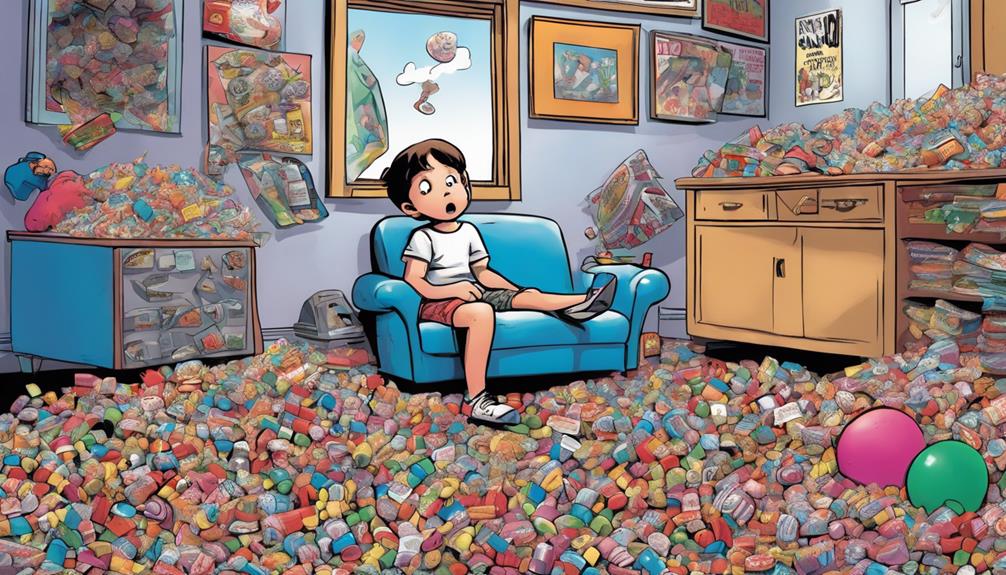
Sugar's impact on children's behavior is often misunderstood, leading many parents to worry about its effects. Research shows that sugar doesn't considerably affect a child's behavior, debunking the myth that it causes hyperactivity. While some kids might display temporary behavioral changes when consuming sugar, this sensitivity isn't consistent across all children.
It's essential for parents and caregivers to recognize that the real culprits behind these behavioral shifts may be artificial additives commonly found in sugary snacks, rather than sugar itself. A 1995 JAMA analysis, along with other studies, found no solid evidence linking sugar consumption to behavioral issues, emphasizing the importance of evaluating other factors in a child's environment.
Moreover, parental beliefs and expectations can shape how you perceive your child's behavior. If you expect sugar to cause hyperactivity, you might notice behaviors that align with that belief, creating a confirmation bias.
Practical Tips for Parents

To help your kids make healthier choices, start by reading nutrition labels carefully and keeping an eye on sugar content.
You can also offer tasty snack alternatives that satisfy their cravings without the added sugars.
Encouraging balanced meal choices at home creates a foundation for better eating habits that can last a lifetime.
Read Nutrition Labels Carefully
Regularly checking nutrition labels is essential for making informed choices about your child's sugary snack consumption. By understanding what's in the food your child eats, you can help reduce their intake of added sugars and hidden sugars that often sneak into processed foods.
Here are some tips to help you navigate nutrition labels:
- Always check both the 'Total Sugars' and 'Added Sugars' sections.
- Remember that 4g of sugar equals 1 teaspoon, making it easier to visualize sugar content.
- Watch out for hidden sugars, as about 70% of processed foods contain added sugars under various names.
- Use the updated Nutrition Facts label to find clear information on added sugars.
Offer Healthy Snack Alternatives
Offering healthy snack alternatives can greatly improve your child's nutrition while reducing their sugar intake. Instead of sugary treats, opt for healthier options like apple slices with peanut butter or carrot sticks with hummus. These snacks provide essential nutrients without the added sugars.
Preparing homemade snacks is another great way to control sugar levels; consider making low-sugar granola bars or yogurt parfaits with fresh fruits. Whole foods are your best friends when it comes to healthier snacking. Stock up on nuts, seeds, and whole-grain crackers to replace processed snacks, which often hide added sugars.
Keeping a variety of low-sugar options readily available makes it easier for your kids to choose healthier alternatives when they get hungry. Involving your children in the snack-making process can also foster a positive relationship with nutritious foods. Let them help prepare snacks, so they feel empowered to make healthier choices.
Encourage Balanced Meal Choices
Encouraging balanced meal choices starts with filling your family's plates with nutrient-dense foods like fruits, vegetables, whole grains, and lean proteins. This simple approach helps your kids meet their daily nutritional needs while promoting healthy growth. Use the nutrition facts label to guide your selections, focusing on foods high in essential nutrients.
Here are some practical tips to encourage balanced meal choices:
- Involve your kids in meal planning and preparation to spark their interest in healthy foods.
- Offer a variety of colorful fruits and vegetables to make meals visually appealing.
- Create a routine of family meals where balanced options are served, fostering a positive relationship with food.
- Introduce healthier alternatives gradually, like homemade granola bars or yogurt with fresh fruit, making nutritious choices more enticing.
Long-Term Effects of Sugar
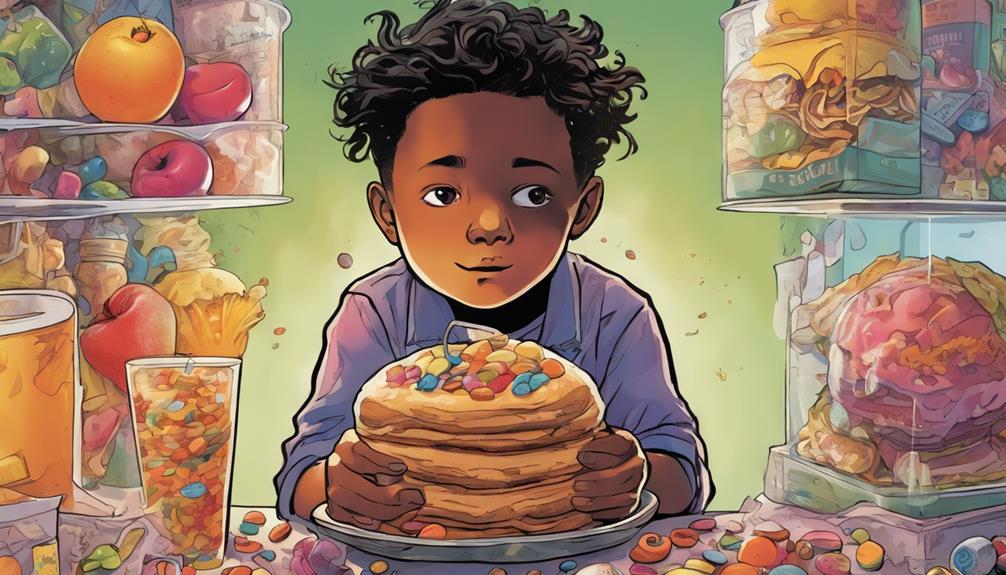
Consuming high amounts of sugar during childhood sets the stage for serious long-term health issues, including obesity and diabetes.
When you allow your child to indulge in sugary snacks, they may develop a preference for sweet foods, making it harder to establish healthier eating habits later on. The American Heart Association suggests that kids aged 2-18 limit their intake of added sugar to less than 25 grams per day. Exceeding this amount can lead to weight gain and increase the risk of developing high blood pressure and other cardiovascular problems.
Moreover, excessive sugar consumption can displace nutrient-rich foods in your child's diet, resulting in deficiencies that impact their growth and development.
If your child consistently consumes high amounts of sugary snacks, they're more likely to experience negative health consequences, such as dental cavities and poor overall health, which can carry over into adulthood.
Promoting Balanced Eating Habits

To promote balanced eating habits, you should encourage your kids to choose nutrient-rich foods over sugary snacks.
Engaging in family meals can help teach them mindful eating practices and the importance of listening to their hunger cues.
Encouraging Nutrient-Rich Choices
Choosing nutrient-rich foods over sugary snacks is essential for ensuring kids get the essential vitamins and minerals they need for healthy growth and development.
When you prioritize these healthier options, you help reduce their sugar intake, which the American Heart Association recommends keeping below 25 grams daily for children.
To support balanced eating habits, consider these tips for encouraging nutrient-rich choices:
- Offer a variety of fruits and vegetables at every meal.
- Include whole grains like brown rice and quinoa in meals.
- Serve lean proteins such as chicken, fish, and beans regularly.
- Limit access to sugary snacks and drinks at home.
Mindful Eating Practices
Mindful eating practices help kids tune into their hunger and fullness cues, making it easier for them to regulate their food intake naturally. By encouraging mindful eating, you're teaching your child to pay attention to what their body is telling them about when to eat and when to stop. This self-regulation is essential in preventing overeating and reducing cravings for added sugar.
To promote balanced eating, establish structured meal and snack times. This routine minimizes impulsive choices, especially when it comes to sugary snacks. You can also enhance your child's interest in nutritious options by involving them in the cooking process. When kids help prepare meals, they're more likely to appreciate the flavors and textures of healthy foods.
Additionally, repeated exposure to healthy options, like vegetables, can increase their acceptance of these foods over time. This way, they'll start to prefer nutritious snacks over sugary alternatives.
Mindful eating not only fosters healthy habits but also cultivates a positive relationship with food that lasts a lifetime. By focusing on balanced eating, you're setting your child up for success in making healthier choices.
Family Meal Engagement
Engaging in family meals not only reinforces mindful eating practices but also creates a supportive environment for kids to develop balanced eating habits. When you prioritize family meals, you're setting the stage for healthier food choices and helping your children reduce high-sugar snack consumption.
Here are some key benefits of regular family mealtime:
- Increased fruit and vegetable intake: Shared meals often lead to more fruits and veggies on the table.
- Better self-regulation: Kids eating with family are more likely to manage their portions and avoid overindulgence.
- Modeling behavior: Your eating habits during meals serve as a powerful example for your children.
- Involvement in cooking: Engaging kids in meal planning and preparation boosts their interest in nutritious foods.
Frequently Asked Questions
Why Should Children Avoid Sugary Foods?
You should encourage children to avoid sugary foods because they can lead to unhealthy weight gain, mood swings, and nutrient deficiencies. Focusing on balanced meals helps them grow stronger and feel better overall.
Why Avoid Sugary Snacks?
You should avoid sugary snacks because they can lead to weight gain, nutrient deficiencies, and mood swings. By choosing healthier options, you'll boost your energy, support growth, and improve your overall well-being.
How Does Sugar Affect Kids' Behavior?
Oh sure, give your kid a candy bar and expect them to behave like a Zen master! In reality, sugar's effects on behavior are muddled, often influenced more by sleep, environment, and individual temperament than the sugary treat itself.
What Are the Side Effects of Sugar in Children?
Excessive sugar can lead to mood swings, fatigue, and poor concentration. It also increases the risk of obesity and dental issues, while crowding out essential nutrients necessary for your child's growth and overall health.
How Do Sugary Snacks Affect Children’s Dental Health?
Sugary snacks can lead to cavities and tooth decay, negatively impacting children’s dental health. This can be especially detrimental during the time period in which teeth kids lose first, as developing teeth are more susceptible to damage from excessive sugar consumption. It’s important to promote healthy snack options to maintain good oral hygiene.
How Do Sugary Snacks Affect Children’s Oral Health?
Sugary snacks can be detrimental to children’s oral health, leading to cavities and decay. It’s important for parents to promote good oral hygiene and limit sugary treats. Encouraging children to brush and floss regularly, and choose the best gums for oral health can help protect their teeth from the harmful effects of sugar.
Conclusion
To sum up, it's vital to help your kids steer clear of sugary snacks for their health and well-being. Consuming too many sugary snacks can lead to an increased risk of tooth decay, obesity, and chronic health conditions such as diabetes and heart disease. It’s important to educate children about the harmful effects of sugary snacks and encourage them to make healthier food choices. By promoting a balanced diet and limiting their intake of sugary snacks, we can help our children develop good eating habits that will benefit them in the long run.
By understanding sugar's impact and promoting healthier choices, you can set them up for a brighter future.
After all, wouldn't you rather see them thrive with energy and focus instead of facing health issues down the line?
Embrace balanced eating habits now, and watch your children flourish as they develop a lifelong appreciation for nutritious foods.


